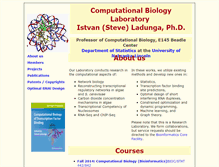 compbio.ucdenver.edu
compbio.ucdenver.edu
Computational Bioscience at the School of Medicine, UC Colorado Denver
Welcome to the Computational Bioscience Program at the University of Colorado Anschutz Medical Campus! The Computational Bioscience Program brings a pioneering new approach to computation that advances human health and the molecular understanding of life. Founded and directed by Prof. Lawrence Hunter, the Program is globally recognized for its research and teaching of computational biology and bioinformatics at the University of Colorado’s Anschutz Medical Campus. The Program is designed to...Students wi...
 compbio.uchicago.edu
compbio.uchicago.edu
Doctoral Training in Computational Genomics | The University of Chicago
Skip to main navigation. Skip to main content. The University of Chicago. Doctoral Training in Computational Genomics. Doctoral Training in Computational Genomics. A look at some of the computational resources available to students and Faculty Computational Resources. A list of the courses that make up the Computational Biology training program Curriculum. Genomics, Genetics, and Systems Biology Committee PhD Program. Human Genetics Departmental PhD Program. Statistics Departmental PhD Program.
 compbio.ucmerced.edu
compbio.ucmerced.edu
Computational Biology at UC Merced
 compbio.ufl.edu
compbio.ufl.edu
Computational Biology and Bioinformatics » UF Health Cancer Center » University of Florida
Training on UF campus. Bioinformatics and computational biology courses @ UF. Text-only version of this website. UF Health at Gainesville. UF Health Shands Hospital. UF Health Shands Cancer Hospital. Shands Emergency & Trauma. UF Health Shands Children's Hospital. UF Health Shands Rehab Hospital. UF Health Shands Psychiatric Hospital. Archer Family Health Care. Student Health Care Center. UF Health at Jacksonville. UF Health Proton Therapy Institute. College of Public Health and Health Professions.
 compbio.umbc.edu
compbio.umbc.edu
Erill Lab
Welcome to the Erill Lab. By ErillLab on April 10, 2013. As Robert Robbins* put it, the DNA sequence of an organism is the result of literally millions of maintenance revisions performed by the worst possible set of kludge using. Opportunistic hackers (i.e. evolution) who delight in clever tricks like writing self modifying code. And relying upon undocumented system quirks . As a result, deciphering molecular biology is the ultimate dream of a computer scientist. What’s cookin’?
 compbio.unl.edu
compbio.unl.edu
Computational Biology Research Lab, Home Page
Istvan (Steve) Ladunga, Ph.D. Professor of Computational Biology, E145 Beadle Center. At the University of Nebraska-Lincoln. Our Laboratory conducts research in the computational aspects of:. Reconstructing transcriptional regulatory networks in algae and S. cerevisiae. Carbon dioxide concentration mechanisms in algae. Transcriptional Competency of Nucleosomes. In these works, we utilize existing methods and develop new ones in:. Transcription factor binding site predictions,. Machine learning, and.
 compbio.ust.hk
compbio.ust.hk
Huang Research Group at HKUST Main/Home Page
Huang Research Group at HKUST. The main goal of our lab is to understand and manipulate functional conformational changes of complex biological systems by developing and applying novel computational tools which bridge the gap between experiments and simulations. Examples of our interested research. Areas include protein misfolding and aggregation, functional conformational changes in Transcription, and the development of Kinetic Network Models for long timescale dynamics. Farewell to Guo and Xu! Congs on...
 compbio.uthsc.edu
compbio.uthsc.edu
Yan Cui's Lab at University of Tennessee Health Science Center
Database, Web Server and Software. Research Interests and Selected Publications. Systems Genetics and Network Biology. Li H, Lu L, Manly KF, Chesler EJ, Bao L, Wang J, Zhou M, Williams RW and Cui Y (2005) Inferring Gene Transcriptional Modulatory Relations: A Genetical Genomics Approach. Li H, Chen H, Bao L, Manly KF, Chesler EJ, Lu L, Wang J, Zhou M, Williams RW and Cui Y (2006) Integrative Genetic Analysis of Transcription Modules: Towards Filling the Gap between Genetic Loci and Inherited Traits.
 compbiochem.berkeley.edu
compbiochem.berkeley.edu
Graduate Study in Comparative Biochemistry
 compbiochem.com
compbiochem.com
Computational Chemistry and Biochemistry
This site is dedicated to computational chemistry and biochemstry.
 compbiodude.blogspot.com
compbiodude.blogspot.com
The CompBio Dude
Biology from the Computational Point of View. Tuesday, July 28, 2009. More Jython and BioJava. The exploration of how it use BioJava with Jython I've written up an example that takes a Genpept file. An does alignments (both NeedlemanWunsch and SmithWaterman) against every Coding feature in a Genebank file. CDS sequences are kept in the Annotations of Features. If you read the straight sequence from the Genebank file, you will get the DNA of the chromosome. From java.io import *. Column uses minimum score.








